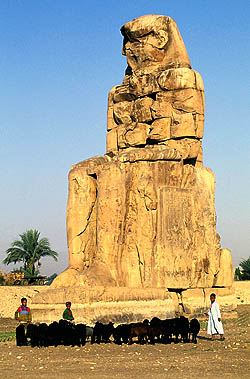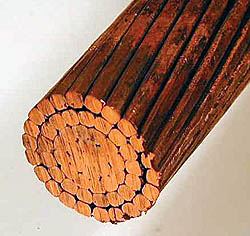
PROTECTING MONUMENTS: The statues known as the Colossi of Memnon near Luxor are irreplaceable works of art: from now on they will be better protected against earthquakes.
Egyptian Pharaohs, Romans and Greeks went to great lengths to be remembered in the future by building monuments which are today of enormous cultural and historical value. Research scientists want to protect these irreplaceable works of art in the Mediterranean from earthquakes. The solution can be a super elastic metal alloy that remembers its original form even if it is deformed.
Metal wires can either be entwined as a safety net around the monument or used to strengthen elements inside it. But first the research scientists need to find the perfect balance between the alloy metals’ properties. This will take place in a laboratory in Trondheim under the leadership of SINTEF research scientist Casper van der Eijk.
INTERNATIONAL JIG-SAW PUZZLE
The project was originally initiated by Italian professor Fabio Casciati from the University of Pavia in northern Italy. Together with structural engineers, seismologists and material scientists, he is working on a project that can extend the lives of our cultural treasures.
“Our job is to solve the material technological piece of the jig-saw puzzle,” says van der Eijk. “We will do this by strengthening monuments with our so-called Shape Memory Alloys.”
This is an alloy that consists of titanium and nickel (Ti-Ni). The alloy has the property that it returns to its original form despite being deformed. But this occurs only under special temperatures. In addition, the metal is super elastic. That means it can stretch more than usual metals because the crystal structure in Shape Memory Alloys can be changed. In such a process, during an earthquake parts of the energy are converted to heat.
“Wires of such materials will, therefore, function as an effective shock absorber,” explains van der Eijk.
DESERT PROBLEMS
The metal has the same strength as steel and can stretch up to seven percent, but nevertheless returns to its original form – if the temperature is stable. Temperature changes are a particular challenge for research scientists in this project. Many of the monuments are located in desert areas where it can be very hot during the day are equally as cold at night. In such conditions, the metal will perform as it should only during parts of a typical 24-hour period.
“An Italian research team has worked on solving the problem with temperature changes by connecting a cooling system to the metal. That would be both expensive and complicated, in part because the device would be reliant on electricity to function,” says van der Eijk.
The Norwegian research scientists have now come up with a more simple solution for the problem: they will attempt to find several alloys that react under different temperatures and join several threads with different properties in one wire. An important factor will be to keep the wires slim enough. Naturally, historical monuments require support that is not too visible. An extra bonus with this solution is that the metal is maintenance free because it does not corrode.

MEMORY METAL: Norwegian scientists will use several alloys with different properties in a single wire
MODELLING
SINTEF is now underway with finding and characterising the different alloys of titanium and nickel. The starting point for the work is an alloy that consists of an equal amount of the two metals. The research scientists will now gradually change the composition to find the optimal solution for Shape Memory Alloys that don’t forget even if the day is hot and the night is cold. The next stage will be mechanical testing and analysis under the microscope.
“Factors like how the metal is produced, which heat treatments they have undergone and how many small impurities they contain are also relevant,” he says. The next stage will then be for the results to be modelled on a computer program taking into account tests, variables and mechanical tests on the different monuments. This will assist with the continued work to find the correct alloys to protect several historical monuments in the future.
“What will such protection cost?” “We must count on each metre of metal costing around 200 kroner. But we need to join several, something that quickly brings the metre price up to 2000 kroner. But if you do it right the first time, it won’t be expensive when you consider that these are ancient monuments that cannot be replaced.”
The post Super net keeps Pharaohs in place appeared first on Geminiresearchnews.com.
